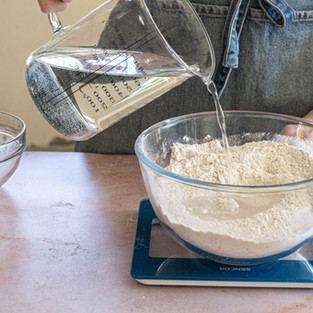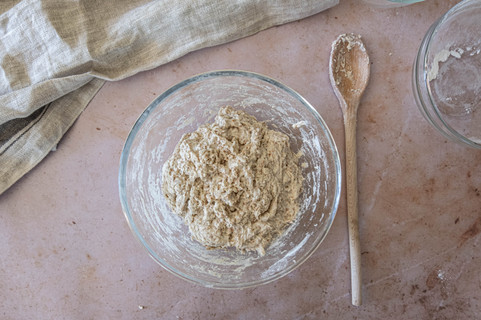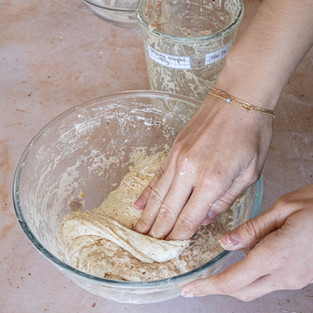Flour, water, and salt. That's it. That's all you need. There is no excuse not to make this bread.

Ingredients
Total Flour 300 g
210 g of bread flour
90 g whole wheat flour
240 g water
60 g starter
6 g salt
IMPORTANT: If using All-purpose flour instead of bread flour, only use 210 g of water.
This recipe yields a small sourdough loaf. After teaching myself how to make sourdough, I thought the easiest and most efficient way to learn how to do it was in a small amount of dough. This way, you can have more control of the process and the dough will be manageable. Once you feel comfortable you can increase the ingredients to bake bigger loaves.
Method
TO PREPARE THE STARTER/LEVAIN
This step depends on the schedule you have your starter on and how long it takes to peak.
STEP 1. First, determine when to feed your starter. In my case, this is about 6 hours before I want to start making my bread; however, this timing is specific to my own starter, and you should feed yours depending on however long it takes your personal starter to peak. Once determined, feed your starter as you usually do. For me, it’s a ratio of 1:5:5 (starter, flour, water). Once fed, set aside.
Important Information:
You cannot bake a loaf of bread with starter coming straight from the fridge. If you keep your starter in the fridge, you must take it out three days before you plan to bake your bread and perform at least three feedings before inoculating your bread dough with the starter.
This is because the wild yeast colony in your starter has been dormant or hibernating whilst in your fridge. Once you take it out of the fridge, the yeasts will not be in a very good mood because you have woken them up. Give it some time to become a happy and bubbly starter once again.
LEVAIN: this is a French term used for the component that will rise your dough (aka leavening agent). Some people decide to make a levain separate to their starter to add to their dough. However, levain and starter function primarily in the same way (and are basically the same thing). I do not make a levain, instead, I just take my starter directly from my starter jar.
TO MAKE THE DOUGH
STEP 0. MEASURE WATER
Measure the 240 g of water in a small jug or glass– something that will allow you to pour it easily. Make sure you actually measure it and have it ready in a container of its own, as this will make the process easier. Do not make the mistake of simply reserving a bunch of water in a jug and measuring it as you pour it in the rest of the ingredients. You’ll see why later.
STEP 1. AUTOLYSE
In a large bowl, combine the bread flour and whole wheat flour and give it a quick whisk. Then, pour in the previously measured water, except for a small amount– maybe leave out the equivalent of what is carried in a shot glass. DO NOT discard the leftover water, it will be used later in the process.
With a wooden spoon or with your hands, mix the water and flour until no dry spots remain. This might take a little while, but do not think you need to add more water– you don’t. Flour takes time to hydrate, so at first, your dough will look dry, but as you keep mixing it, it will hydrate and become wet and sticky.
This step requires no kneading whatsoever. We are just looking to hydrate the flour, and not to develop gluten– so no kneading, just mix to combine.
Cover your bowl with plastic wrap or a damp kitchen towel and let rest for 30 minutes to 2 hours (or more) I recommend you start with a 2 hour autolyse for maximum gluten formation, and as you become more comfortable with the process and gain more knowledge, you can adjust this to your schedule and needs.
I recently found silicone covers at IKEA that seal your bowl as plastic wrap would. If you want to reduce your use of plastic, this is a great option.
After the autolyse, your dough will be extendible and flexible, being able to pass the windowpane test (which you can read bout in my basic brioche dough recipe), like in this picture:

The timing here is tricky because your starter might take longer to peak, so don’t worry if you let the dough rest for longer than what is called for. As a rule of thumb: the more time you are able to let it autolyse, the better.
Important information:
Autolyse is the process when flour and water are left to rest for a long period of time. Its purpose is to start the gluten development process, as gluten develops in two ways: with time and with force (kneading). Autolysing your dough is going to boost gluten development and reduce the need for kneading your dough too much later on.
When I want to make bread early in the morning, I leave the dough to autolyse overnight. That way, I can wake up early (6/7 am) and use my starter, that had been maturing overnight, and pour it straight away into the autolysing dough that had been sitting for about 7-9 hours.
If you are using All-purpose flour, let your dough autolyse only for 30 minutes. In this case, it is critical for your dough to reach that 30-minute mark, so try not to add your starter before that. Just as with the 2 hour autolyse, make sure you plan your starter/levain for it to be ready when you need it.
STEP 2. ADD IN THE STARTER/LEVAIN
When your starter is at its peak and you have been autolysing your dough for about 2 hours (30 minutes if you’re using all-purpose flour), add in the called for amount right on top of your dough.
Next, you will have to incorporate your starter into your dough. To do so, take the sides of your dough and fold them towards the middle, so as to enclose your starter. Keep doing this a couple more times around the dough (folding towards the middle) to incorporate the starter. You can then start to knead the dough to make sure the starter is equally distributed throughout the dough. Knead for about 5 minutes to incorporate the starter thoroughly.
If you have one, you can do this step in a stand mixer, as well. I have a KitchenAid Artisan, and when I first add the starter, with the dough hook attachment, I knead for 1-2 minutes on low speed (speed 2 or 3) and then 3-4 minutes on medium-high speed (speed 6 or 7).
After you have incorporated your starter into your dough, cover the bowl in plastic wrap or a damp kitchen towel and let rest for 30 minutes. Your dough will become even more flexible and extendible and will pass the windowpane test with flying colors, like in this picture:

Important Information:
How do I know if my starter is ready/is at its peak?
When you feed your starter, it’ll start to grow as time goes by. At some point, for me, it’s around six hours after its feeding, the starter peaks. You can tell this when it stops growing and the dome shape it had during its growth begins flattening out.
The float test
One way to test if your starter is ready is by performing something referred to as the float test. To do this, fill a small bowl with water, then, with a small spoon, take some of your starter and drop it into the water. If it floats, your starter is at its peak (aka prime point). If, however, it does not float, your starter needs more ripening time, provided that it has not gotten beyond its peak point.
Lately, I have not been relying too much on the float test because my starter floats even hours past its peak point. Instead, I go by visual queues– when it looks like it has reached its peak (top is flat rather than domed) and when it smells fruity and not too vinegar-y.
If your starter is not ripe enough it might not be able to leaven your bread correctly, and you will have to extend its bulk fermentation period and increase the temperature of the dough during bulk fermentation. If, on the other hand, your starter has gone past its peak, it will be more acidic and it can “eat” your dough’s gluten structure while its bulk fermenting and resting in the fridge (later on in the process). This means that when you bake your bread, the gluten structure will not be strong enough and your bread will collapse and will not have a nice rise.
STEP 3. ADD IN SALT
Uncover your bowl and sprinkle in the amount of salt called for. Next, pour in the leftover water that you did not use from the autolyse step. This is why I strongly recommend measuring the water in a container before you start anything. It is important that you know exactly how much water you are adding, so when you want to recreate the recipe you are in total control, as variant amounts of water have varying effects in your dough.
To incorporate the salt and the leftover water, fold the dough the same way you did to incorporate the starter. After a couple of folds, grab your dough in your hand and close your hand to form a fist. The dough will ooze and break through your fingers. Repeat this movement until the salt has been evenly distributed throughout the dough – about 3 minutes.
At first, your dough will look like a shaggy mess. You will most likely have a pool of water in your bowl as you incorporate the salt. This is completely normal. Keep mixing until all the water has been absorbed.
Next, dump the dough into your work surface (un-floured) and slap and fold your dough for about 5 minutes.

To do this, use both hands and slip your fingers under the north and south sides of your dough, with your right hand on the north, and your left hand on the south. Lift up the dough and rotate it clockwise 90° so that your right hand is now on the east side and your left hand on the west side. Slap the dough into the counter, slapping first the south side and folding the north side over it. Repeat. Also, don’t be shy, really slap the dough on the counter.
I thought it was quite hard to explain the slap and fold process with just images and words, so I recorded a video too:
After slapping your dough for 5 minutes, transfer it back into your bowl and cover it with plastic wrap or a damp kitchen towel. Let rest for 30 minutes.

STEP 4. BULK FERMENTATION + STRETCH AND FOLDS
In my opinion, this step is the most crucial in the sourdough bread process. It’s where you’ll start to ferment your dough, leaven it, and build up strength so you can have a dramatic oven spring (oven rise) and an open crumb.
You will let your dough rest/bulk ferment for a total of 3 hours and perform a total of four stretches and folds with a final 1 hour of bulk fermentation. Let’s break it down:
In the previous step, you added the salt and let the dough rest 30 minutes. These are your first 30 minutes of bulk.
After those 30 minutes are up you will perform what is referred to as stretch and folds (S&F).
There are two different ways in which you can perform stretch and folds:
Stretch and Folds:
Wet your hands and slide one hand under the north side of the dough. Gently grab the dough and pull it upwards, as far as it will go before it starts resisting (DO NOT tear the dough). Then fold the dough over to the south side – this is one S&F. Turn your bowl clockwise 90° so that the west side is now your north side and repeat the stretch and fold you just did. Repeat until you have done a S&F on ALL sides of the dough, which would be 4 total.
This is one set of stretch and folds.
Here is a video to illustrate this step better:
Coil Folds
This is my preferred method.
Wet your hands and tuck them in at either side of the dough (east and west). Lift your hands (lifting and stretching the dough) and then lower them with a forward motion, folding the dough on itself. Repeat the same motion on the same side until the top half of the dough has folded onto itself almost entirely. At this point, you should have some dough leftover to fold on the south side of your container. Flip your container 180° so that the north side is now the south side. Repeat the coil fold to tuck in that leftover portion of the dough. At this point, you have now folded the dough on two of its sides and now have to do so on the remaining two. Rotate your bowl 90° so that the north and south sides are now the east and the west, then repeat the coil folds you did previously.
This is one set of coil folds.
As always, when words and pictures fall short, count on me to have a video:
Stretch and fold 1 (S&F):
Perform one set of S&F or coil folds.
Make sure you really stretch the dough in this initial set of folds. It is essential that you do so for good gluten development and dough strength.
Cover with plastic wrap or a damp kitchen towel and let rest for 30 minutes.
S&F 2
At this point, your dough has been bulk fermenting for a total of 1 hour.
Uncover your dough and perform another set of S&F or coil folds just like you did before.
For this second set of folds, you also want to stretch it quite aggressively.
Cover and let rest for another 30 minutes.
S&F 3
At this point, your dough has been bulk fermenting for a total of 1 hour and 30 minutes.
Uncover your dough and perform another set of S&F or coil folds just like you did before.
This time you want to be gentler, as the dough will be fuller of air and you do not want to deflate it.
Cover and let rest for another 30 minutes.
S&F 4
At this point, your dough has been bulk fermenting for a total of 2 hours.
Uncover your dough and perform another set of S&F or coil folds just like you did before.
Likewise, be very gentle with this last fold.
Cover and let rest for a final 1 hour.
When the final hour of bulk fermentation has passed, your dough has been bulk fermenting for a total of 3 hours.
This now marks the end of the bulk fermentation period
Important Information:
If you have a thermometer, make sure you control your dough’s temperature before and after each fold. The temperature should be 26°C
If you do not have a thermometer you should get one. Controlling your dough’s temperature at this stage is very important. On one hand, if your dough’s temperature is lower than 26°C you will have to bulk ferment it for longer, and if you don’t, your dough will be under fermented, which will have repercussions in its flavor and its rise in the oven. On the other hand, if your temperature is higher than 26°C your dough will over-ferment and will have problems holding its shape which will lead to a mediocre rise in the oven.
Conclusion: get a thermometer.
If you definitely can’t or won’t get a thermometer, you can still make sourdough. However, do not expect your bakes to be consistent, and do not expect an excellent yield. If your kitchen is too hot, try to find a cool place in your house where you can store the dough as it goes through bulk fermentation and stretch and folds. On the contrary, if your kitchen is too cold, look for a warmer place (oven (OFF) with the light on and the door cracked open is a good alternative)
STEP 5. PRE-SHAPING
If you have been doing coil folds:
Wet your hands and perform one last set of coil folds, being extremely gentle. Your dough should feel full or air.
If you have been doing S&F:
Wet your hands, and carefully grab the dough in your hands and turn it upside down in the container. Perform a set of COIL FOLDS very very gently.
Once again with wet hands, take your dough and lift it out of the container and onto your work surface (un-floured). With the help of a wet bench scraper and wet hands, drag the dough around in the counter to get rid of the fold seams and to create tension in its surface. Do not overdo it as you will risk tearing your dough. Cover with an upside-down bowl and let rest for 30 minutes.
If you do not have a bench scraper, you should look into getting one. This is another extremely useful tool. But, you can still pre-shape your dough by gently grabbing your dough with both hands and dragging it in circular motions around your work surface, as seen on the video.
STEP 6. SHAPING
Dust the top of your dough with AP flour (not rice flour – rice flour has an incredible power of making things NOT stick, but in this case we want the dough to stick to itself).
Now, all in one motion, slide your bench scraper under your dough, lift it and rest the dough on your other hand flour side down. After, put down your bench scraper and use your newly free hand and cradle the dough with both hands, and gently place it on the work surface, seam side up (floured side down). With floured hands, gently (I cannot stress this enough) stretch the sides of your dough degassing it just a bit, until you have a somewhat rectangle.
To shape a batard (long-ish shaped loaf):
1. Grab the right side of the dough with both hands, stretch it a little bit and fold it over to the left side.
2. Grab the left side and repeat.
3. Grab the top (north) side, stretch it a little bit and fold it over 1/3 of the way down towards the south side. Then, with one hand in either side (east and west) roll the dough towards yourself (south side) using your thumbs to tuck the dough as you go.
4. Let the dough rest in your work surface for 5 minutes covered with a kitchen towel.
5. Slide your bench scraper under the dough, lift it and rest the dough seam side up on your free hand, put down your bench scraper and use that hand to hold the dough with both hands, like before. Then, place inside your proofing basket (dusted with rice flour), seam side up.
Don't worry! I recorded a video here too:
To shape a boule (round loaf):
Do steps 1-3 from above
4. Try to dust off the flour on your work surface and using your bench scraper or your hands and drag the dough around the counter to shape it into a ball.
5. Create a cup with your hands and place them on the north side of the boule and drag the dough towards you, always making sure your hands are touching the work surface. Do this 3-4 times, rotating the dough.
6. Let the dough rest on the work surface for 5 minutes covered with a kitchen towel to help seal the seams underneath.
7. Slide your bench scraper under the dough, lift it and rest the dough seam side up on your free hand, put down your bench scraper and use that hand to hold the dough with both hands. Then, place inside your proofing basket (dusted with rice flour).
Cue the video:
Let the dough rest in the proofing basket for 10-15 minutes. This is a light proof before it goes into the fridge. After those 10-15 minutes your dough, when poked, should bounce back slowly and leave a small indent. If not, keep resting until it does, but this should not take long.
Cover your proofing basket with a kitchen towel and place in the fridge overnight, ideally 12-14 hours. However, you can keep your dough in the fridge for way longer than this. Do not feel like you need to be exact with this timeframe, as many people leave their dough in the fridge for 2-3 days, which allows the final product, once cooked, to be sourer and more digestible.
STEP 6. SCORING AND BAKING
When you are ready to bake your loaf, preheat your oven to the highest temperature it can go (most home ovens will go up to 250°C / 482°F). Make sure you preheat your Dutch oven or baking cloche as you preheat your oven for a minimum of one hour.
When you have preheated your oven and bread baking utensil for one hour, take your proofing basket out of the fridge and onto your work surface. Lay a generous amount of parchment paper on your work surface, flour the top of your dough (the exposed part) with rice flour or AP flour and turn it over into the parchment paper. Then, with a bread lame, a razor blade, or an EXTREMELY sharp knife, make an off-centred, somewhat deep incision on your dough from north to south. For better results, keep your lame or knife at a 45° angle as you score your dough.
Scoring a batard:
Scoring a boule:
Important Information:
It is important that your cut is deep. If it’s too superficial it will be like not even scoring at all. This will allow the bread to rise in a controlled manner, as you are basically telling it where to expand. This will also allow your dough to expand as much as it needs, opening up the crumb.
If your bread bursts in parts where there is no cut, it means that your scoring was not deep enough. If you do not score deep enough, your bread will not be able to rise as much and you will end up with a tight crumb.
Helping yourself with the parchment paper, transfer your dough into your Dutch oven. You can trim the parchment paper if you think there is too much. Just make sure you have enough to comfortably move the dough to and from the Dutch oven.
Place the lid on your Dutch oven and transfer into the oven, on the lowest rack/position. Bake for 20 minutes covered, then remove the lid and bake for another 15-30 minutes. You want to keep an eye on your bread at this point. Let it bake until it is deep, deep golden brown. In some ovens where I’ve baked sourdough loaves before, it has taken 15 minutes, in my home oven it takes around 25-30 minutes, so it all depends on your oven.
When the loaf has reached the desired color, remove the Dutch oven from the oven, place it on your stovetop (careful! It will be extremely hot!) and using the parchment paper, take the loaf out of the Dutch oven and place it onto a cooling rack (without the parchment paper).
Let it cool COMPLETELY – about 3-4 hours. You do not want to slice open the bread before it has cooled down (I know, sad) because, as it does, it is still releasing trapped steam that is “still cooking” your bread on the inside. If you cut it open while warm and let that steam escape, you risk having an irregular consistency of your bread.
To store, keep bread in a paper bag or bread box for 4-5 days. After that, slice the whole loaf (if you haven’t devoured it already) and transfer it to the freezer in a Ziplock bag. Whenever you want a slice, just pop it in the toaster and you’ll have a delicious slice of homemade bread in minutes.



































































Comments